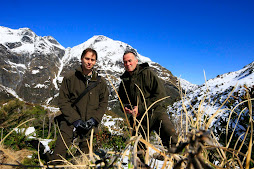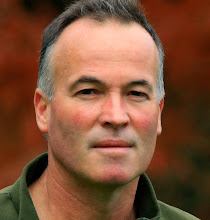By Bill Benfield -
Dear Professor Sir Paul Callaghan.
I was quite amazed to see your "sanctuary vision" in the Dominion Post of 9/12/11 which claims the provision of sanctuaries could avert disaster to our native wildlife. It seems an unusual approach to take, but then, someone with your obvious abilities and with the academic resources available to you, would have at least have had a look around the subject, boned up a bit on the science, and what was happening in the field and what information there was. Still, I was surprised. that you went and leaped in on this one.
Naturally you would have studied the origins of our fauna and flora, of how the forests co-evolved with giant browsing birds which are now extinct. I suspect you would have caught ecologist Graeme Caughley’s papers where he argues that excluder fences or exclosures, such as you are proposing, which deny any browse, even exotic browse, means that the forest, and in effect the ecosystem, becomes "un-natural".
I’m sure that when you proposed further aerial poisoning with 1080 for areas outside the sanctuaries, you would have been aware that this poison was originally registered as an insecticide. Your investigations would have shown that studies revealing the disturbing impact of massive 1080 drops on forest floor invertebrates were suppressed within the Department of Conservation. As a scientist, you must be aware that insects are the base of all forest ecosystems, the creatures that break down forest litter to make forest soils, the base of the food chain for many birds including both kiwi and fantails. When insects are being poisoned on a short cycle, such as in the Tararua Ranges for "Project Kaka" you will soon have a silent forest. No cicadas, no flies, no crickets, and soon no birds! Nothing to do with "pests".
No doubt your investigations revealed that many of the larger birds, such as kea and kaka, are being directly poisoned by aerial 1080 operations such as you propose. Recent kea poisonings include 41% of a radio tagged population in 2008 at Franz, and in September of this year, nearly 80% of a population at North Okarito. Kea are now extinct on much of their former range. Although DoC may claim the culprits are stoats and possum, I don’t think it needs much science to see that there is another very significant factor, ie. poisoning, that is being ignored.
I take it you also read the papers by Ruscoe and others concerning rat plagues which follow a year or so after 1080 operations. This is in part because rats breed so much faster than our native birds, so while everything is knocked back by the poisoning, fast breeding rats are able to recover and occupy the niches of others, and the balance is tipped into the rat's favour to the detriment of the birds. Contrary to claims by DoC and others, stoats food preferences mean that they are often little affected by 1080 operations.
If you were able to get on an Official Information Act request, the minutes of the clandestine steering committee consisting of DoC, Animal Health Board (AHB) and Animal Control Products (ACP, the state owned poisons producer) set up to ensure the successful renewal of consents by ERMA to use aerial 1080, you will find some interesting reading. Amongst the snippets is the information that DoC had been using artificially low costings for aerial 1080 (similar to the figures given by Gerry McSweeny of Forest & Bird on National Radio of 8/6/11). Reading this material, and the statement of corporate intent of the state owned enterprise, ACP, you will probably come to the conclusion that something more is afoot. Here the example of Enron provides an interesting parallel. A large energy conglomerate that is still regarded as a benchmark for corporate malfeasance deliberately created crisis’s to exert leverage on regulators and gain pecuniary advantage. In the case of Enron, they created threats to the electricity supply by deliberately reducing generating capacity during periods of peak usage. The real difference here is that in New Zealand, it is both the state and leading conservation groups that are rogue.
Starting with DoC, they have an association with the Nga Manu Trust, near Levin. This seems to be an open air photo studio where, in contrived settings, vegetarian possum are induced to be photographed attacking fledgling birds. The photos are then widely used in publicity material making possum out to be a threat to our endangered bird life, and hence, along with a lot of similar material, a false crisis in conservation. So too you will find with the Royal NZ Forest & Bird Protection Society, whose advocate, Nicola Vallence , in an effort to talk up a crisis of a possum plague, claims that marsupial possum are different in New Zealand because, although they can still carry only one joey, "they have more babies here".
The AHB, by means of poorly policed stock movement controls and ineffective testing regimes, maintains both a created crisis and a body of bovine Tb in the environment to ensure their continued existence. All of these groups make a bogeyman of possum and other "pest" threats to create a sense of crisis which they harvest for leverage and pecuniary advantage in much the same way as did Enron. You’d think that in a normal world, a free press would pick up on this, but when it comes to things like DoC’s and the other players advocacy budgets, media managers will sit mum to avoid de-railing a state sponsored gravy train that they all benefit from. National Radio is just as bad.
No doubt you also had the opportunity to check out many of the bio-diversity restoration and "kiwi recovery" type programmes. These are great vehicles for seeking bequests, engaging corporate sponsors and other such fund raising, but did you get a chance to check out the overall impact on the native species involved? One of them, which has Hubbards breakfast foods as a corporate sponsor, is the Kea Conservation Trust. It is claimed that this trust helped prepare the poison baits which lifted the kea kill rate from 41% of a population in 2008 to nearly 80% this year. Good to know that, while eating your muesli, you are at the same time contributing to the extinction of kea in the wild.
Your researches will have no doubt led to DoC "rarebits" where that you may have found the kiwi recovery programmes can have an equally catastrophic effect. Kiwi are interesting, in that they are the only ratite to survive the human invasion of this country. Left to themselves, they have both adaptation and enough nous to get on with their lives, despite that fact, they have become caught up in the conservation "crisis". The usual way it effects kiwi is by having their eggs taken before time for their chick to be hatched and raised to a few months in a hatchery before being returned to the wild, encumbered with a harness carrying a tracking device. They soon fall prey to some predator, possibly cats; and the howl will go up that there is a "pest problem"!
To a kiwi hatched in its parent's burrow, there will be the adult mentoring, social bonding and protection by the older birds. Chicks of some, like the Okarito brown or rowi kiwi, can spend up to two years or more with the parent birds and siblings, and by the time they are ready to leave the nest, they are well equipped with all the skills to face their world. Compare that to the hatchery chick! Turkeys may be a good analogy - a bird which in the wild is known for its skill and wary ability to evade predators, yet farm reared birds are, well, just "turkeys". Same too for hatchery reared kiwi; if they don’t die of starvation tangled by their tracker harness in the undergrowth, they will soon succumb to something in what is to them a strange and hostile world.
Is the course of conservation you seek really an over - managed and poisoned conservation estate, where a few "iconic" species are protected from life in the wild, often encumbered with tracking devices to the point where they are no longer viable outside the expensive sanctuaries such as you suggest? Because the land outside the sactuaries will have been so carpet bombed with deadly poison as you advocate, will we only be left with token populations that would face sure death outside the wire? There is an alternative., It will require some courage and it is outlined in my book"The Third Wave – Poisoning the Land" published by Tross Publishing of Wellington. It should be read by all with an interest in our land, its forests and its creatures.
Respectfully,
Bill Benfield.











